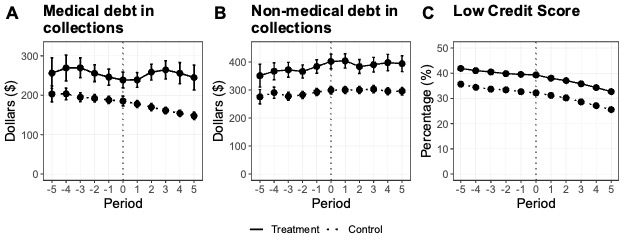Health Services Research
Session: Health Services Research 2: Novel Methods and Disparities
302 - Financial Outcomes Among Caregivers of Hospitalized versus Non-Hospitalized Children: A Difference-in-Differences Analysis
Saturday, May 4, 2024
3:30 PM - 6:00 PM ET
Poster Number: 302
Publication Number: 302.1362
Publication Number: 302.1362
- EC
Erin Carlton, MD, MSc (she/her/hers)
University of Michigan Medical School
Ann Arbor, Michigan, United States
Presenting Author(s)
Background: A child’s hospitalization may cause financial strain for families. However, the long-term financial impact of hospitalization on caregiver finances is unknown.
Objective: To estimate the impact of a child’s hospitalization on caregiver credit outcomes; medical and non-medical debt in collections and credit scores.
Design/Methods: Using commercial insurance claims linked to longitudinal commercial credit data, we identified caregivers of children (age 0-17 years) with and without hospitalization in January 2018-February 2020. Children without a hospitalization were assigned a “phantom” hospitalization date. Hospitalized children were matched to non-hospitalized children on medical complexity, age group, sex, rurality, income quartile, number of caregivers, and month/year of hospitalization/phantom hospitalization. Credit outcomes of the primary planholder (caregiver) on the child’s insurance plan were examined. Using a difference-in-differences design, we used one or two-part generalized linear models with a log link to estimate the effect of hospitalization on the amount of medical and non-medical debt in collections, among those with any debt and overall, respectively. Using logistic regression models, we estimated the effect of hospitalization on the probability of having low credit scores ( < 660).
Results: 14,091 caregivers of hospitalized children were matched to 50,026 caregivers of non-hospitalized children. The unadjusted proportion of caregivers of hospitalized children with non-zero medical debt in each period increased from 19.8% to 20.2% in the pre- vs post-hospitalization periods compared to 15.7% to 15.4% for caregivers of non-hospitalized children. Overall mean medical debt increased by $36 (95% CI 14, 58) for caregivers of hospitalized children post-hospitalization compared to the non-hospitalized cohort. Among those with non-zero medical debt in collections, caregivers of hospitalized children owed $175 (95% CI 70, 279) more post-discharge. There were no significant increases in the amount of non-medical debt in collection or rates of low credit score in the post-discharge period for caregivers of hospitalized vs non-hospitalized children (Figure).
Conclusion(s): A child’s hospitalization is associated with a modest increase of medical debt in collections, but there were no significant changes in the amount of non-medical debt in collections or proportion of caregivers with a low credit score. As family finances and child health are intricately intertwined, policies to minimize the financial burden of a child’s hospitalization could improve long term health outcomes.

